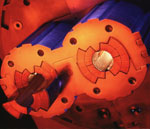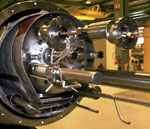|

 A construction tunnel in the LHC. Parts of the
ATLAS detector
will be lowered through here and attached to the accelerator ring.
A construction tunnel in the LHC. Parts of the
ATLAS detector
will be lowered through here and attached to the accelerator ring.
|
The tunnel that houses the accelerator ring of the LHC is probably CERN’s most distinctive feature. Measuring 27 km in circumference, much of the ring exists under land in France, while the majority of CERN’s other facilities are in Switzerland.
Scientists need such a large ring in order to accelerate particles to the enormous levels of energy required in some experiments. The underlying principles are similar to those in a linear accelerator. But with machines like the LHC, scientists can accelerate the particles as far as needed by just making them "run laps" around the ring.
 Superconducting dipole magnet in the LHC.
Superconducting dipole magnet in the LHC.
photo: CERN
|
The LHC will be constructed in the tunnel that now houses the Large Electron Positron
Collider (LEP), which has been the site of experiments searching
for the
Higgs Boson
. The
LHC is expected to be up and running by 2005.
Particles will enter the LHC from the Super Proton Synchotron.
They'll be moving with extremely high energies. Such extreme
conditions require very strong magnetic fields to control
the direction of the beams. The magnets used to do this
are called "superconducting" magnets, because
the materials they are made of can conduct electricity
at very low temperatures without incurring any resistance.
In order to make them superconducting, the magnets have
to be cooled with liquid helium to 1.9 degrees Kelvin,
about 300 Celsius degrees below room temperature.
 End view of the 15-meter dipole magnet.
End view of the 15-meter dipole magnet.
photo: CERN
|
The LHC tunnel will actually hold two side-by-side beam pipes to accelerate beams of protons that are moving in opposite directions. Those beams will be smashed together, and the resulting spray of particles will be analyzed. To study what happens when the beams collide, there will also be two new detectors installed in the LHC. These huge detectors will handle as much as 10 million pieces of information for each collision in the beam pipe.
|
|
Experimenters at the LHC are looking for clues to the origins of the laws governing nature. How? By creating the conditions that existed less than a billionth of a second after the Big Bang occurred.
Right now, the universe is fairly cool, temperature-wise. But when the Big Bang occurred, things were extremely hot, about 10
15
degrees. Materials behave differently at high temperatures. For example, when iron atoms are very hot -- when they have a lot of energy -- they float freely as a gas, and iron has no particularly special properties. But let them cool down and form a solid, and you get a metal that can conduct electricity and create a magnetic field.
Physicists believe that by heating matter (in other words, accelerating protons), and watching as it cools down, they can tell something about the forces that were behind the creation of the elementary particles. They expect to find the Higgs field, which fills the universe uniformly and interacts with particles, giving them mass.
|
|